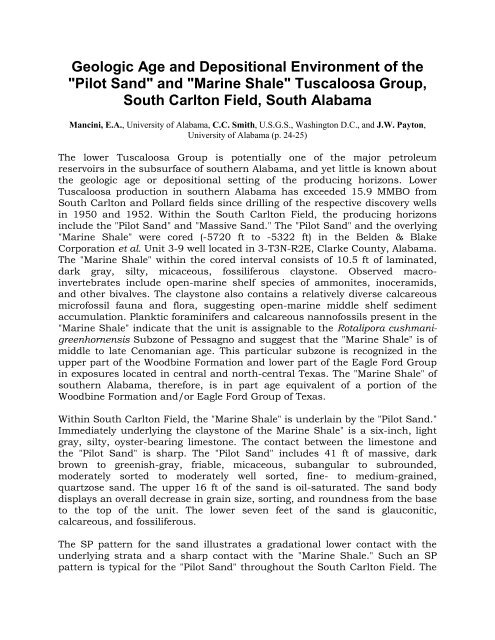1st Research Conference - Gulf Coast Section SEPM
1st Research Conference - Gulf Coast Section SEPM
1st Research Conference - Gulf Coast Section SEPM
You also want an ePaper? Increase the reach of your titles
YUMPU automatically turns print PDFs into web optimized ePapers that Google loves.
Geologic Age and Depositional Environment of the<br />
"Pilot Sand" and "Marine Shale" Tuscaloosa Group,<br />
South Carlton Field, South Alabama<br />
Mancini, E.A., University of Alabama, C.C. Smith, U.S.G.S., Washington D.C., and J.W. Payton,<br />
University of Alabama (p. 24-25)<br />
The lower Tuscaloosa Group is potentially one of the major petroleum<br />
reservoirs in the subsurface of southern Alabama, and yet little is known about<br />
the geologic age or depositional setting of the producing horizons. Lower<br />
Tuscaloosa production in southern Alabama has exceeded 15.9 MMBO from<br />
South Carlton and Pollard fields since drilling of the respective discovery wells<br />
in 1950 and 1952. Within the South Carlton Field, the producing horizons<br />
include the "Pilot Sand" and "Massive Sand." The "Pilot Sand" and the overlying<br />
"Marine Shale" were cored (-5720 ft to -5322 ft) in the Belden & Blake<br />
Corporation et al. Unit 3-9 well located in 3-T3N-R2E, Clarke County, Alabama.<br />
The "Marine Shale" within the cored interval consists of 10.5 ft of laminated,<br />
dark gray, silty, micaceous, fossiliferous claystone. Observed macroinvertebrates<br />
include open-marine shelf species of ammonites, inoceramids,<br />
and other bivalves. The claystone also contains a relatively diverse calcareous<br />
microfossil fauna and flora, suggesting open-marine middle shelf sediment<br />
accumulation. Planktic foraminifers and calcareous nannofossils present in the<br />
"Marine Shale" indicate that the unit is assignable to the Rotalipora cushmanigreenhornensis<br />
Subzone of Pessagno and suggest that the "Marine Shale" is of<br />
middle to late Cenomanian age. This particular subzone is recognized in the<br />
upper part of the Woodbine Formation and lower part of the Eagle Ford Group<br />
in exposures located in central and north-central Texas. The "Marine Shale" of<br />
southern Alabama, therefore, is in part age equivalent of a portion of the<br />
Woodbine Formation and/or Eagle Ford Group of Texas.<br />
Within South Carlton Field, the "Marine Shale" is underlain by the "Pilot Sand."<br />
Immediately underlying the claystone of the Marine Shale" is a six-inch, light<br />
gray, silty, oyster-bearing limestone. The contact between the limestone and<br />
the "Pilot Sand" is sharp. The "Pilot Sand" includes 41 ft of massive, dark<br />
brown to greenish-gray, friable, micaceous, subangular to subrounded,<br />
moderately sorted to moderately well sorted, fine- to medium-grained,<br />
quartzose sand. The upper 16 ft of the sand is oil-saturated. The sand body<br />
displays an overall decrease in grain size, sorting, and roundness from the base<br />
to the top of the unit. The lower seven feet of the sand is glauconitic,<br />
calcareous, and fossiliferous.<br />
The SP pattern for the sand illustrates a gradational lower contact with the<br />
underlying strata and a sharp contact with the "Marine Shale." Such an SP<br />
pattern is typical for the "Pilot Sand" throughout the South Carlton Field. The
















